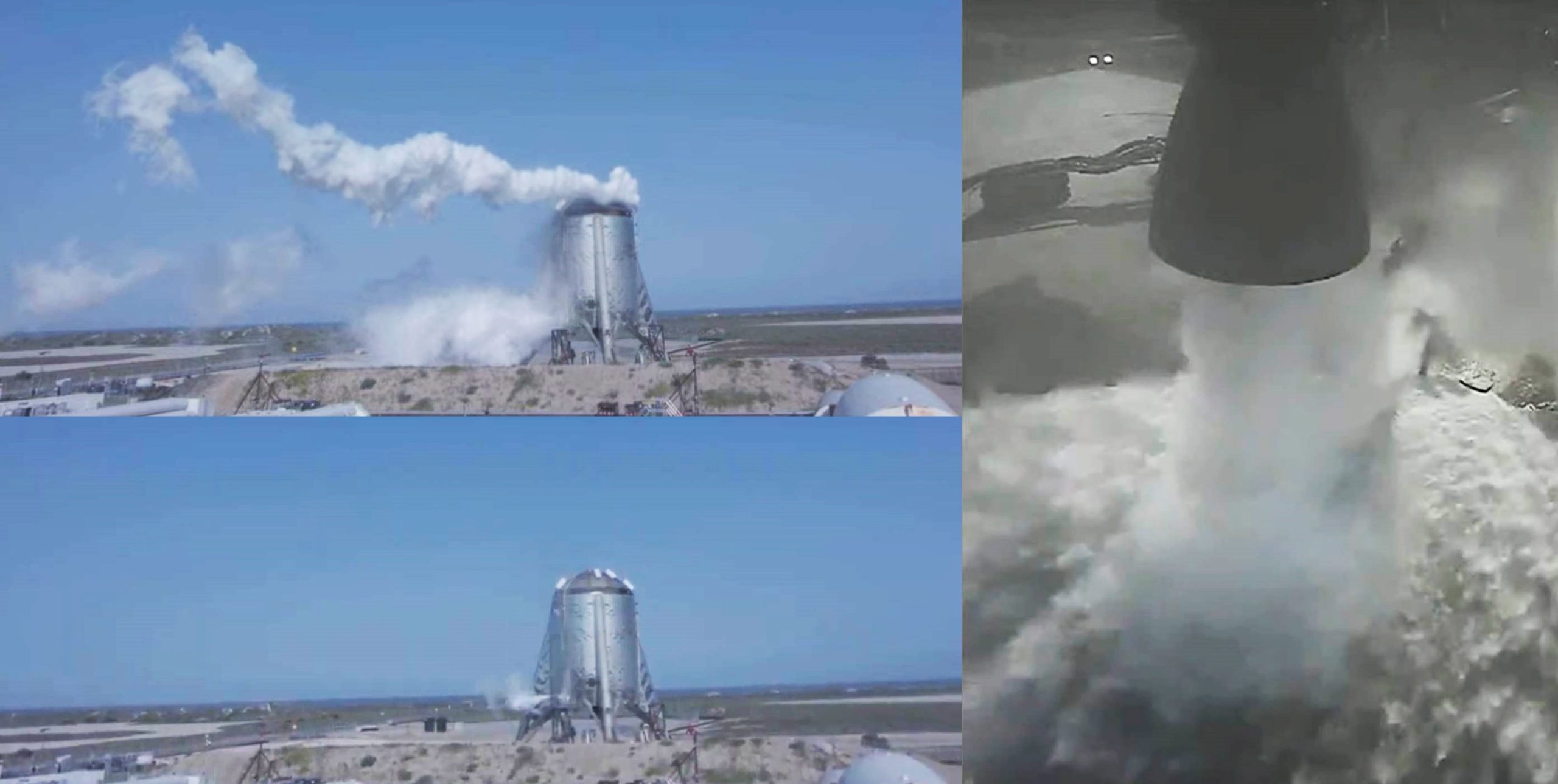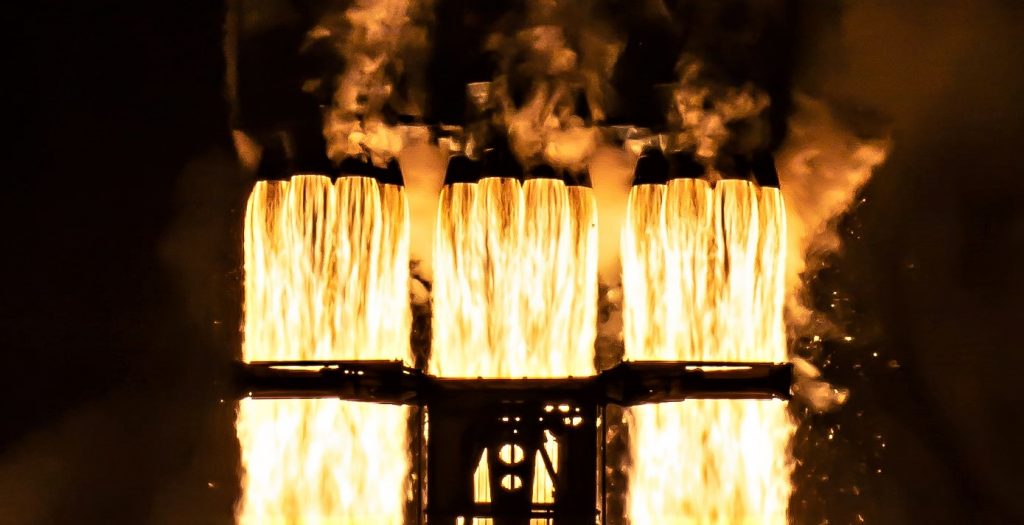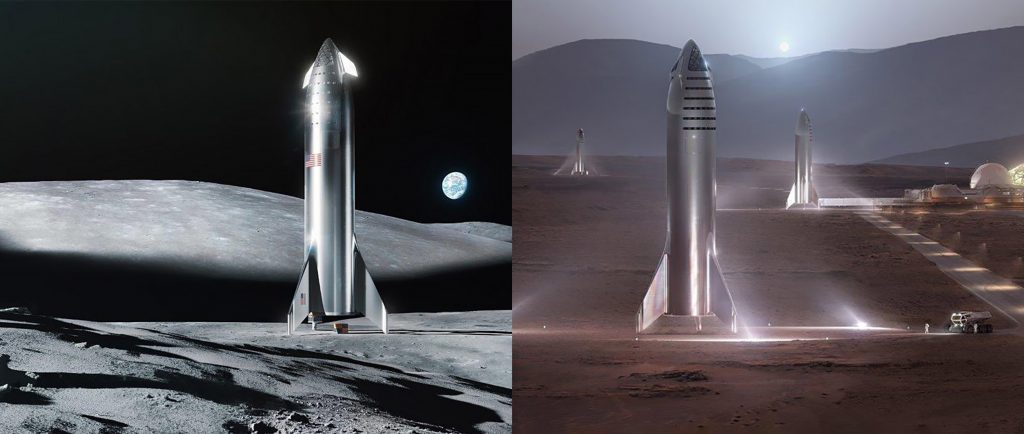

News
SpaceX scrubs Starhopper’s final Raptor-powered flight as Elon Musk talks “finicky” igniters
For unknown reasons, SpaceX’s Starhopper prototype suffered a hold just 0.8 seconds prior to its second planned flight test, a hold that was eventually followed by a decision to scrub the August 26th attempt and try again tomorrow, August 27th.
Starhopper is a full-scale, partial-height testbed for SpaceX’s next-generation Starship launch vehicle, serving more as a semi-mobile test stand for steel rockets and Raptor engines than an actual Starship prototype. The unusual vehicle took flight for the first time ever on July 25th, reaching an altitude of roughly 20m (65 ft) under the power of a single Raptor engine, capable of producing up to 200 tons (450,000 lbf) of thrust. That test also suffered a minor scrub on the 24th, followed by a successful flight one day later, a chapter that Starhopper may now mirror on its second attempted flight, a 150m (500 ft) hop.
Notably, SpaceX CEO Elon Musk took to Twitter just seconds after the rocket’s scheduled liftoff suffered a last-second hold to indicate that Raptor’s torch igniters were proving somewhat finicky relative to the chemical alternative used by SpaceX’s proven Merlin engines.
The CEO later confirmed that that comment was directly related to the 26th’s scrub, indicating that Raptor serial number 06 (SN06) needed to have its igniters inspected prior to a second hop test attempt, now scheduled to occur no earlier than 6pm EDT (22:00 UTC) on August 27th. The gist of the difficulties with Raptor’s igniter starts with the reason that SpaceX is attempting to integrate an entirely new form of ignition into the engine, replacing the methods successfully used over tens or even hundreds of thousands of seconds of firing with the company’s Merlin 1 and Merlin Vacuum engines.
Merlin 1D and MVacD both rely on a relatively simple, reliable, cheap, and easy method of chemical ignition, using a duo of pyrophoric materials known as triethylaluminum-triethylborane (TEA-TEB). When mixed, these materials immediately combust, generating an iconic green flash visible during Falcon 9 and Heavy launches, and thus producing the ‘spark’ needed to start Merlin engines.

Generally speaking, TEA-TEB is an excellent method of igniting rockets, even if it is more of a brute-force, inelegant solution than alternatives. It does, however, bring limitations: every single ignition requires a new ‘cartridge’ be expended, fundamentally limiting the number of times Merlin 1D (and Merlin Vacuum) engines can be ignited before and after liftoff.
This doesn’t even consider the fact that TEA-TEB are extremely complex chemical products that would be next to impossible to produce off of Earth, at least for the indefinite future.
To combat these downsides, SpaceX has designed Raptor with an entirely different method of ignition, known as torch ignition. Technically speaking, Raptor’s power, design, and methalox propellant combine to demand more than a relatively common solution, in which spark plugs are used to ignite an engine. Instead, Raptor uses those spark plugs to ignite its ignition sources, what CEO Elon Musk has described as full-up blow torches. Once ignited, those blow torches – likely miniature rocket engines using the same methane and oxygen fuel as Raptor – then ignite the engine’s methane and oxygen preburners before finally igniting those mixed, high-pressure gases in the combustion chamber.
In simple terms, the fact that Raptor is a full-flow staged-combustion (FFSC) engine means that the pressures it must operate under are extreme, verging on unprecedented in large-scale rocketry. Extremely high-pressure gases (on the order of 3,000-10,000+ psi or 200-700+ bar) are just as difficult to reliably ignite, especially if hypergolic solutions (i.e. TEA-TEB) are off the table.
To get an even ignition – critical to avoid burn-through, minor explosions, and even catastrophic engine failures – Raptor’s torch ignition may actually involve a 360-degree ring of spark plug-lit torches around the point of ignition, an undeniably complex solution.

However, as Musk notes, these significant, “finicky” challenges brought on by Raptor’s exotic ignition method are motivated by the potential benefits such a solution might bring. Relative to Merlin 1D’s TEA-TEB ignition, torch ignition – once optimized and matured into a reliable solution – will permit an almost unlimited number of Raptor ignitions before, during, and after flight.
Avoiding TEA-TEB and other complex chemical igniters also means that Starship will technically be able to launch to Mars or the Moon, perform injection and landing burns, maybe even hop around the surface, and still be able to return to Earth – all without resupply. Such a return voyage would still be predicated on the ability to generate the methane and oxygen propellant needed to fuel Starships, but – assuming that challenge can be solved – torch-lit Raptors would be ready for such a mission. In the event that, say, something like August 26th’s scrub happens to a Starship on Mars, the crew would also be able to get out, inspect Starship’s Raptors, and even replace faulty spark plugs if necessary.

Technically, one could bring lots of spare TEA-TEB cartridges and install those in space or after landing, but those cartridges are quite literally firebombs waiting to ignite, whereas spare spark plugs are entirely inert.
For now, we’ll have to wait for SpaceX technicians to get their eyes and hands-on Starhopper’s lone Raptor engine to verify that its ignition hardware is in good health. If all goes well, Starhopper will attempt its final flight test as early as August 27th.
Update (August 27th): Starhopper is reportedly set for a second attempted 150m (500 ft) flight test today, scheduled to occur no earlier than 5pm EDT (21:00 UTC) on August 27th. Stay tuned for SpaceX’s official Livestream!
Check out Teslarati’s Marketplace! We offer Tesla accessories, including for the Tesla Cybertruck and Tesla Model 3.

News
Tesla starts showing how FSD will change lives in Europe
Local officials tested the system on narrow country roads and were impressed by FSD’s smooth, human-like driving, with some calling the service a game-changer for everyday life in areas that are far from urban centers.

Tesla has launched Europe’s first public shuttle service using Full Self-Driving (Supervised) in the rural Eifelkreis Bitburg-Prüm region of Germany, demonstrating how the technology can restore independence and mobility for people who struggle with limited transport options.
Local officials tested the system on narrow country roads and were impressed by FSD’s smooth, human-like driving, with some calling the service a game-changer for everyday life in areas that are far from urban centers.
Officials see real impact on rural residents
Arzfeld Mayor Johannes Kuhl and District Administrator Andreas Kruppert personally tested the Tesla shuttle service. This allowed them to see just how well FSD navigated winding lanes and rural roads confidently. Kruppert said, “Autonomous driving sounds like science fiction to many, but we simply see here that it works totally well in rural regions too.” Kuhl, for his part, also noted that FSD “feels like a very experienced driver.”
The pilot complements the area’s “Citizen Bus” program, which provides on-demand rides for elderly residents who can no longer drive themselves. Tesla Europe shared a video of a demonstration of the service, highlighting how FSD gives people their freedom back, even in places where public transport is not as prevalent.
What the Ministry for Economic Affairs and Transport says
Rhineland-Palatinate’s Minister Daniela Schmitt supported the project, praising the collaboration that made this “first of its kind in Europe” possible. As per the ministry, the rural rollout for the service shows FSD’s potential beyond major cities, and it delivers tangible benefits like grocery runs, doctor visits, and social connections for isolated residents.
“Reliable and flexible mobility is especially vital in rural areas. With the launch of a shuttle service using self-driving vehicles (FSD supervised) by Tesla in the Eifelkreis Bitburg-Prüm, an innovative pilot project is now getting underway that complements local community bus services. It is the first project of its kind in Europe.
“The result is a real gain for rural mobility: greater accessibility, more flexibility and tangible benefits for everyday life. A strong signal for innovation, cooperation and future-oriented mobility beyond urban centers,” the ministry wrote in a LinkedIn post.
News
Tesla China quietly posts Robotaxi-related job listing
Tesla China is currently seeking a Low Voltage Electrical Engineer to work on circuit board design for the company’s autonomous vehicles.

Tesla has posted a new job listing in Shanghai explicitly tied to its Robotaxi program, fueling speculation that the company is preparing to launch its dedicated autonomous ride-hailing service in China.
As noted in the listing, Tesla China is currently seeking a Low Voltage Electrical Engineer to work on circuit board design for the company’s autonomous vehicles.
Robotaxi-specific role
The listing, which was shared on social media platform X by industry watcher @tslaming, suggested that Tesla China is looking to fill the role urgently. The job listing itself specifically mentions that the person hired for the role will be working on the Low Voltage Hardware team, which would design the circuit boards that would serve as the nervous system of the Robotaxi.
Key tasks for the role, as indicated in the job listing, include collaboration with PCB layout, firmware, mechanical, program management, and validation teams, among other responsibilities. The role is based in Shanghai.
China Robotaxi launch
China represents a massive potential market for robotaxis, with its dense urban centers and supportive policies in select cities. Tesla has limited permission to roll out FSD in the country, though despite this, its vehicles have been hailed as among the best in the market when it comes to autonomous features. So far, at least, it appears that China supports Tesla’s FSD and Robotaxi rollout.
This was hinted at in November, when Tesla brought the Cybercab to the 8th China International Import Expo (CIIE) in Shanghai, marking the first time that the autonomous two-seater was brought to the Asia-Pacific region. The vehicle, despite not having a release date in China, received a significant amount of interest among the event’s attendees.
Elon Musk
Elon Musk and Tesla AI Director share insights after empty driver seat Robotaxi rides
The executives’ unoccupied tests hint at the rapid progress of Tesla’s unsupervised Robotaxi efforts.

Tesla CEO Elon Musk and AI Director Ashok Elluswamy celebrated Christmas Eve by sharing personal experiences with Robotaxi vehicles that had no safety monitor or occupant in the driver’s seat. Musk described the system’s “perfect driving” around Austin, while Elluswamy posted video from the back seat, calling it “an amazing experience.”
The executives’ unoccupied tests hint at the rapid progress of Tesla’s unsupervised Robotaxi efforts.
Elon and Ashok’s firsthand Robotaxi insights
Prior to Musk and the Tesla AI Director’s posts, sightings of unmanned Teslas navigating public roads were widely shared on social media. One such vehicle was spotted in Austin, Texas, which Elon Musk acknowleged by stating that “Testing is underway with no occupants in the car.”
Based on his Christmas Eve post, Musk seemed to have tested an unmanned Tesla himself. “A Tesla with no safety monitor in the car and me sitting in the passenger seat took me all around Austin on Sunday with perfect driving,” Musk wrote in his post.
Elluswamy responded with a 2-minute video showing himself in the rear of an unmanned Tesla. The video featured the vehicle’s empty front seats, as well as its smooth handling through real-world traffic. He captioned his video with the words, “It’s an amazing experience!”
Towards Unsupervised operations
During an xAI Hackathon earlier this month, Elon Musk mentioned that Tesla owed be removing Safety Monitors from its Robotaxis in Austin in just three weeks. “Unsupervised is pretty much solved at this point. So there will be Tesla Robotaxis operating in Austin with no one in them. Not even anyone in the passenger seat in about three weeks,” he said. Musk echoed similar estimates at the 2025 Annual Shareholder Meeting and the Q3 2025 earnings call.
Considering the insights that were posted Musk and Elluswamy, it does appear that Tesla is working hard towards operating its Robotaxis with no safety monitors. This is quite impressive considering that the service was launched just earlier this year.








